
- 季新的漁業文化
Jixin’s Fishery Culture - 存仁的農漁生活
Farming and Fishing in Cunren - 匏崙的山城風貌
Paolun: A Mountain Village - 羅東中山的繁盛
Thriving Zhongshan Luodong - 宜蘭舊城的手工匠藝
Yilan’s Old Town Handicrafts - 成興鴨母寮
Yamuliao, Chengxing - 大海心‧龜山情
Longing to Return to Guishan Island and Life on the Ocean - 蘇南的古往今昔
Sunan: Yesterday and Today - 仁德的紅瓦厝
Rende’s Red-tiled Houses - 慶和流傳的古早味
Traditional Tastes of Qinghe - 南津的人文歷史
Nanjin’s Culture and History - 客庄情懷‧茶藝飄香
Kezhuang and the Aroma of Tea
宜蘭社區日曆
Yilan Community Calendar
一本捨不得撕的日曆
以「社區」為主角的日曆,一日一頁一主題,訴說家鄉土地的故事。
社區日曆發想自員山阿蘭城李金墻先生期待在日曆看見家鄉,促成「阿蘭城影像日誌」,亦催生至今執行18年,每年徵選12個社區,記錄216個故事的「宜蘭縣社區日曆」。
社區日曆是高度社區動員的歷程,一起討論如何讓社區被看見,本身就是一門基礎的社區資源盤點知識,也是社區合力創造光榮感的過程。是一種愉悅的擾動,是社造沃土萌芽起始,亦是社造初試啼聲。
社區日曆結合社造是全國創舉,紮實穩健地陪伴社區啟動、成長。大夥兒同心相聚,聽耆老憶兒時、聞長輩訴家常,在不間斷的談笑中,探詢過往的美好、走入鄉間的歷史,將流轉回憶化為文字,躍然紙上,就是這一本「捨不得撕的日曆」。
季新的漁業文化
季新社區是由以前季水村和新店村組合而成,東瀕太平洋、西接冬山河,四周環水,是典型的漁村生活型態;社區舊有噶瑪蘭平埔族三社(流流社、婆羅辛仔宛社、加禮宛社),然大多平埔族皆已通婚漢化;過去居民靠捕魚維生,現則依賴養殖漁業,多飼養蝦、香魚、龍膽石斑等。

A calendar so beautiful, you won't want to turn the page
A daily calendar starring local communities: a new day, a new page, a new topic, each telling the story of Yilan.
The idea for a community calendar came from Mr. Li Jinqiang in Yuanshan Township's Alancheng, who wanted to see his own hometown featured in its pages. This led to the Alancheng image journal, which in turn gave birth to the Yilan County Community Calendar that features 12 different communities each year. Over the past 18 years, the calendar has spotlighted the stories of 216 communities.
To produce the calendar, communities must be highly mobilized and discuss how to best show off their hometowns. This in itself requires residents to build a basic community resource inventory, while working together to create a sense of pride in their community. The process creates a flurry of activity, fertile soil that can nurture the sprouts of community development, which is a first step in empowering residents.
The community calendar was the first of its kind in Taiwan and has been a companion to communities as they start down the path of development. Everyone gathers together with the same purpose, listening to the elderly remember their childhoods and discuss their daily lives. While talking and laughing together, residents can learn about the past and experience the history of their communities. These memories are turned into words that jump off the page to create a calendar that you will want to keep long after those days have passed.
Jixin’s Fishery Culture
Jixin Community was created by combining Jishui and Xindian Villages. Surrounded by water with the Pacific Ocean to the east and Dongshan River to the west, community residents lead the classic fishing village lifestyle. The community was originally home to three Kavalan pingpu groups (Liuliu [流流社], Polo Sinnawan, and Jialiwan [加禮宛社]), whose members primarily married Han people and were sinicized. In the past, residents relied on fishing for their livelihoods, while today many farm sweetfish, giant grouper, and shrimp.

存仁的農漁生活
存仁社區舊名功勞埔,一說為先人協助朝廷擊退海賊有功,官署賜給功勞田十甲,故稱「十甲功勞」;二說為古時沿岸蘆葦成林,稱做「菅林埔」,後因守防海賊有功,便取諧音改為「功勞埔」。
本地早期以農耕和牽罟為主,「功勞埔好水土」代表金黃稻作豐收的沃土,湧泉、濕地、埤等水文生態豐富;信仰中心為供奉五顯大帝的定安宮。

Farming and Fishing in Cunren
Cunren Community was formerly named Gonglaopu, where it is said residents assisted the imperial court to repel marauding pirates and were rewarded with land for their trouble. A different origin story says that the village actually got its name from the surrounding reed forest.
In the area’s early days, residents took advantage of its fertile land and fish-filled waters by making a living through agriculture and beach siene fishing. Natural springs, wetlands, and ponds add to Cunren’s ecological richness. Religious life centers around the Ding’an Temple dedicated to worshipping Wuxian Dadi.

匏崙的山城風貌
匏崙社區地勢山形酷似葫勺,古稱匏杓崙,後簡稱「匏崙」。聚落完整,蜿蜒小徑如小城。
早期常民生活多與廟宇祭祀相關,較特別的是組織巡守隊、設隘寮,以防禦泰雅族攻擊;山上燒木炭提煉樟腦油、種植茶葉、應用柴馬挑柴等皆是舊時生活。另為共同取用珍貴山泉資源,居民發展出特殊「分水缸」飲水文化。

Paolun: A Mountain Village
The mountainous terrain of Paolun was said to look like a gourd ladle, called a paoshao, which gave the community its original name, Paoshaolun. This was later shortened to Paolun. The quaint settlement features winding paths that give it the appearance of a small town.
Early in its history, most residents’ lives revolved around temples and religious festivals. The community set up a patrol and guard towers to defend against attack by the Atayal indigenous people. Life also included burning wood to extract camphor oil, growing tea, and collecting firewood. In order to share the mountain spring, residents developed a unique method to parcel out this precious limited resource.

羅東中山的繁盛
中山社區以中山公園之意命名,面積雖小,卻是羅東最精華繁榮的地段,羅東夜市及宜蘭縣地王皆位於此。社區內的信仰中心為奠安宮,供奉主神玄天上帝,廟宇內的雕樑畫棟、門牆彩繪甚為精緻,還有許多遠近馳名的小吃,如;已有70年歷史的公園杏仁茶;專賣紅豆湯圓的50年老店;50多年的傳統小吃米苔目、帝爺廟口前的喥咕麵、公園的元氣早餐阿枝油飯、五六年級生常去的冰雪;揚名國際的包心粉圓等,個個都讓人翹起大拇。
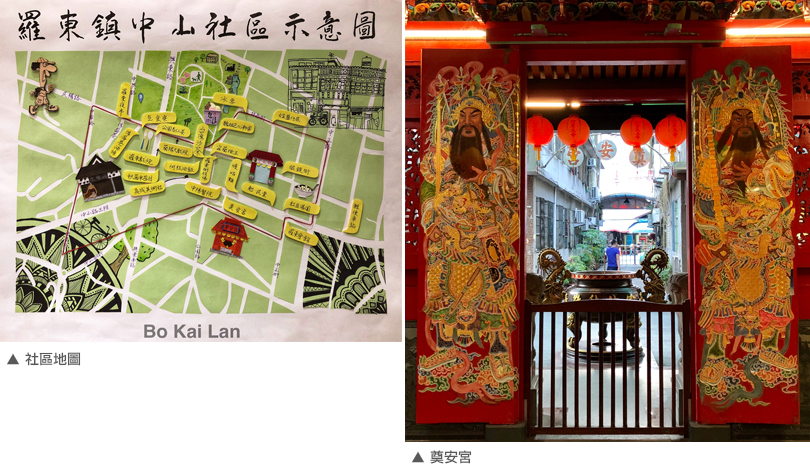
Thriving Zhongshan Luodong
Zhongshan Community was named after neighboring Zhongshan Park. While small in area, it is centrally-located in the most prosperous area of Luodong. Both the Luodong Night Market and Yilan County’s most expensive real estate are located in Zhongshan. The religious center of the community is Dianan Temple, primarily dedicated to worship of Xuandi, which features intricate carvings and rich decorations of exceptional quality. People travel from far and wide to enjoy foods from famous long-standing establishments like Gongyuan Almond Tea that has been operating for 70 years and a red bean soup with rice dumplings stand with 50 years of history. Other famous eats include a five-decade-old purveyor of traditional thick rice noodles, Duku Noodles, A-Chi Taiwanese Sticky Rice, and Ice Snow, a favorite among the elementary school set. Local stuffed pearl tapioca has even made a name for itself abroad. These local snacks get a big thumbs up from all who try them.

宜蘭舊城的手工匠藝
 宜蘭中山社區位於宜蘭市舊城區,舊稱十六坎,由坎興門至兌安門區域圈起,極似一把扇子,骨架正是一條條街道,在川流不息的街道上,廟宇環聚、江湖藝人藏匿於此,ㄧ幢幢日式建築泛著古意,一間間傳產工坊及小吃店面,烙上遊子們的笑容印記,充滿歷史氣息與文化軌跡,蘊藏古色古香的繁榮現代城市。
宜蘭中山社區位於宜蘭市舊城區,舊稱十六坎,由坎興門至兌安門區域圈起,極似一把扇子,骨架正是一條條街道,在川流不息的街道上,廟宇環聚、江湖藝人藏匿於此,ㄧ幢幢日式建築泛著古意,一間間傳產工坊及小吃店面,烙上遊子們的笑容印記,充滿歷史氣息與文化軌跡,蘊藏古色古香的繁榮現代城市。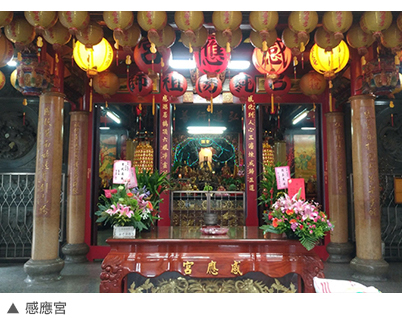
Yilan’s Old Town Handicrafts
 Zhongshan Community, formerly known as Shiliukan, is located in old town Yilan between Kanxing Gate and Duian Gate. Shaped like a fan, the streets stretch outward like the fan’s ribs. Cars and motorbikes stream through the streets, which are lined with many temples. Itinerant artists hide out here and rows of Japanese-style buildings suffuse the area with an old time feel. Traditional workshops and food stands bring smiles to the faces of visitors. The area, steeped in history and traditional culture, is a quaint corner of a prosperous modern city.
Zhongshan Community, formerly known as Shiliukan, is located in old town Yilan between Kanxing Gate and Duian Gate. Shaped like a fan, the streets stretch outward like the fan’s ribs. Cars and motorbikes stream through the streets, which are lined with many temples. Itinerant artists hide out here and rows of Japanese-style buildings suffuse the area with an old time feel. Traditional workshops and food stands bring smiles to the faces of visitors. The area, steeped in history and traditional culture, is a quaint corner of a prosperous modern city. 
成興鴨母寮
成興社區位在五結鄉東南部,原分為成興庄與下清水庄(埤仔尾與寶斗厝),後合併為「成興村」,即是現在的成興社區,因地域臨海,地質屬沙型,春種豆類、秋植蘿蔔,符合土性及節氣,品質極佳。
社區內有著名的五十二甲生態溼地,另有深具地方歷史特色的成興鴨母寮,及促進產業蓬勃的利澤工業區
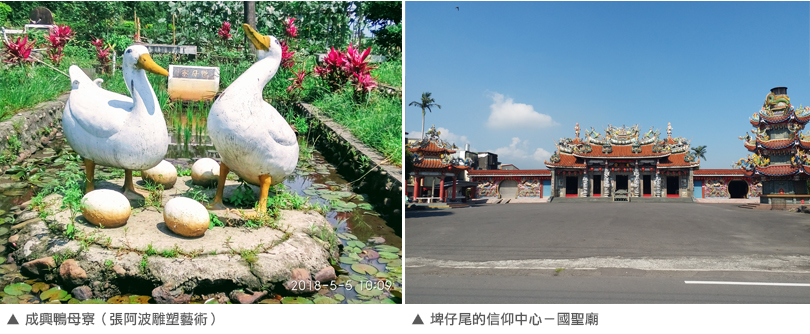
Yamuliao, Chengxing
Chengxing is located in southeastern Wujie Township. Originally split into two separate areas, Chengxing Zhuang and Xiaqingshui Zhuang, these were combined to create Chengxing Village, which is today’s Chengxing Community. The sandy soil of this coastal community is perfect for growing beans in the spring and radish in the fall. Thriving in the local soil and climate, the community produces outstanding quality produce.
The famous Wushierjia Wetlands are located here as is Yamuliao, a place of deep historical significance. The community is home to Lize Industrial Park that helps promote a prosperous local economy.

大海心‧龜山情
龜山島原有繁榮漁村,1975年因軍事管制而被迫遷村,1977年興建國宅106戶,名為「仁澤社區」。1994年第一屆全國文藝季,宜蘭舉辦「歸來吧!龜山」活動,離鄉島民首度重返龜山島,隨後展開正名陳情,2001年終於正名「龜山里」及「龜山島社區」。今日居民仍以海上漁業活動為主、拱蘭宮信仰中心,傳承島上特殊童玩打寸子、72角風箏,延續龜山島的人文故事

Longing to Return to Guishan Island and Life on the Ocean
Guishan Island was once home to a thriving fishing village. In 1975, residents were forced to move when the military took control of the island. Then in 1977, residents moved into the 106 public housing apartments in a complex named Renze Community. As part of the 1994 National Festival of Culture and Arts, Yilan held Longing to Return to Guishan Island! where former residents returned to the island for the first time in nearly 20 years. Later, a petition was circulated to rename their new area Guishan Urban Village and Guishan Island Community, which was achieved in 2001. Today, most residents still make their living from the sea. The center of religious life is Gonglan Temple. Residents maintain their traditions brought from the island of playing cunzi, a children’s game, and flying 72-cornered kites.

蘇南的古往今昔
蘇南社區位於蘇澳街之南,左鄰蘇澳溪(白米溪)、右有冷泉溪,是鎮內最熱鬧的市區之一;日治時期蘇澳地區行政中心就在本里內,戰後因社區鄰近鐵、公路站,往來商旅非常多,帶動了市區繁華,爾後由於北迴線開通,市況不如往昔。目前市區內仍有許多商家、旅社、超商、金融機構,生活機能十分便捷。
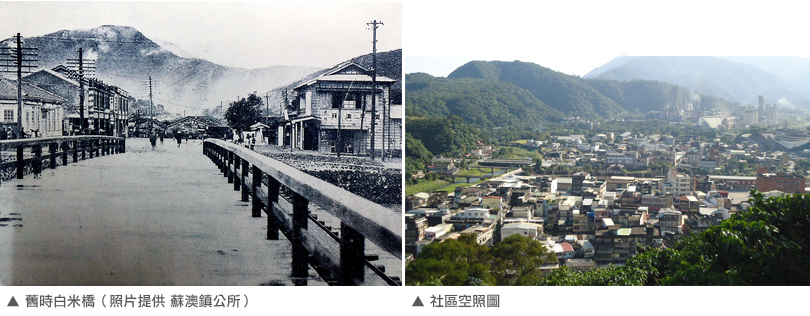
Sunan: Yesterday and Today
Su’nan Community is located south of Su’ao Street, with Su’ao River to the left and Cold Springs River to the right, and is one of the liveliest areas of the township. During the Japanese Occupation, the Su’ao District Administration Center was located in Su’nan. Following World War II, area train and bus stations brought travelers from around the country into Su’nan along with their business. However, when the new North-link Rail Line opened, Su’nan was bypassed and the economy slowed. Today, Su’nan still houses many businesses, hostels, supermarkets, and financial institutions, making it a very convenient place to live.

仁德的紅瓦厝
仁德社區位於羅東街廓,當地人士首建紅瓦厝於此,故舊稱「紅瓦厝」;另因當地為北管「福蘭社」大本營,且常與西皮派發生械鬥(西皮福祿之爭),為倡議寬恕仁愛,使其成為仁風道德之所在,命名「仁德」。社區內有月眉圳水岸生態豐富,北管子弟戲,糖醃鴨肉、炭燒味豆漿、美味甜甜圈等人文、美食匯集。

Rende’s Red-tiled Houses
Rende Community is bordered by Luodong Street and was known as the red tile district, after the red tile houses first built here. The community was also a base of the Fulan Troupe, in the Beiguan musical tradition, which often had conflicts with the Xipi faction (Xipi Fulu Battles). In order to promote forgiveness and empathy between the groups, the area was named Rende, meaning compassionate integrity. Located on the bank of the Yuemei River, Rende is blessed with rich ecological resources and delights for all the senses including Beiguan opera, sugar-marinated duck, soy milk cooked over a wood fire, and Taiwanese doughnuts.

慶和流傳的古早味
宜蘭舊城有「平安順興」四個城門,東為「震平」門、西為「兌安」門、南為「離順」門、北為「坎興」門,慶和社區位屬北門,因慶和廟得名,慶和廟又稱為馬舍公廟,供奉輔順將軍,約有200年歷史;早期俗稱「豬灶」的人工屠宰場也在社區內,現已改建為「宜蘭縣社會福利館」;社區內百年老店如老元香牛舌餅創始店遠近馳名。
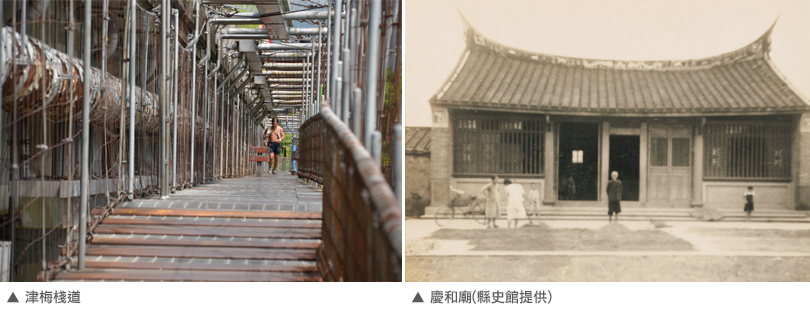
Traditional Tastes of Qinghe
The old city of Yilan was once protected behind city walls, with four gates allowing access. Located where the North Gate once stood, Qinghe Community is named after Qinghe Temple, which has over two centuries of history and is dedicated to worship of General Fushun. The local abattoir was once located here, but the building was torn down and the Yilan County Social Welfare Center built in its place. Stores established over a century ago, such as Laoyuanxiang Ox-tongue Shaped Biscuits, are known far and wide.

南津的人文歷史
南津社區位於蘭陽溪北岸,是由南往北進入宜蘭市的門戶,舊稱壯二林彪城(城仔),社區因蘭陽溪流域肥沃土壤,蔥、蒜、西瓜、稻米等產量豐富,品質優良。社區內有優質公園式聚落的縣政中心、相鄰的縣議會,以及「三舉一貢」的李氏宗祠,皆是人文與生態的優美環境。另外利隆麵龜、天下第一蒜、槌子南瓜都是知名社區的特色產品
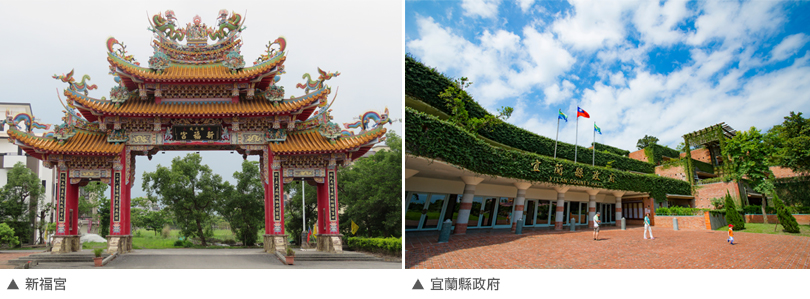
Nanjin’s Culture and History
Nanjin Community is located on the northern bank of the Lanyang River and lies at the entrance to Yilan city from the south. Formerly named Zhuanger Linbiao Cheng, the community can thank the Lanyang River basin for fertile soil that yields abundant, high-quality green onion, garlic, watermelon, and rice. Both the County Government Administration and Yilan County Council are located here, along with the Lee Clan Shrine. The area is rich in both cultural and ecological resources. Famous local delicacies include Lilong Turtle Buns, garlic, and pumpkin.

客庄情懷‧茶藝飄香
據傳泰雅族人稱玉蘭為Helan(鋸木廠之意),漢人以台語轉音記為玉蘭,日人發音為Gyokuran,亦稱為幽沽浪。玉蘭社區是個寧靜小山村,多以茶葉種植為主,全村雖只有40幾戶卻族群多元,包括泰雅族人、客家人、外省人、閩南人,文化多元豐富。社區除了以茶為主業外,近年許多精緻民宿、風味餐廳、茶香小吃等等,讓社區成為優質的休閒農業體驗區。

Kezhuang and the Aroma of Tea
According to legend, Yulan was originally named Helan, meaning sawmill in the Atayal language. Taiwanese speakers changed this to Yulan, while in Japanese the area was known as Gyokuran, and was also called Yougulang. Yulan Community is a quiet mountain village that primarily relies on tea cultivation. While it is only home to around 40 households, the population is surprisingly diverse. Residents come from a variety of backgrounds including Atayal indigenous people, Hakka, mainland Chinese, and Minnan people from earlier Chinese migration to the island. In recent years, bed and breakfasts, restaurants, and tea-flavored snack stands have popped up in the community, making it a great place for visitors to relax and experience local agriculture.


Copyright© 蘭陽博物館版權所有
